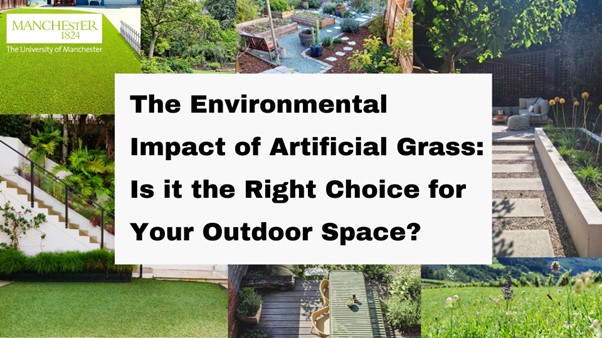
Artificial grass is not as green as it might seem
Written by Anna Thompson, undergraduate student in Biology.
Artificial grass – it’s probably not something you have given much thought to. However, it has risen in popularity in sports settings over the last 20 years, and homeowners are increasingly choosing to install it in their gardens and outdoor spaces. In the UK, 11% of homeowners have already replaced their lawn with artificial grass and a further 10% also plan to make the swap (Aviva, 2024), with many stating that its low maintenance nature was the deciding factor for making the change.

A cross-section of artificial grass created in BioRender.
Confusingly, manufacturers have marketed artificial grass as a ‘green product’ and ‘environmentally friendly’ because it uses less water and pesticides than natural grass. However, upon further research, it appears that the only green thing about artificial grass is its colour. To address this misinformation as part of my final year project, I created a website aiming to educate prospective buyers of artificial grass about the hidden environmental impact, to help them make an informed decision before purchase.
The environmental concerns related to artificial grass are summarised below:
- Manufacturing artificial grass requires intense heat and energy and transporting it to installation sites increases its carbon footprint.
- Artificial grass degrades relatively quickly after it is installed. This can result in the release of microplastics and other contaminants. Microplastics are transported into the environment via rainwater runoff and wind, where they can infiltrate food chains and pose serious risks. As microplastics are increasingly recognised as a serious threat to human health and the environment, reducing their production and release should be a global priority. Alongside this, as the fibres degrade, they can release potentially harmful chemicals into the air and soil. These include Volatile Organic Compounds (VOCS), Polycyclic Aromatic Hydrocarbons (PAHs) Per- and Polyfluoroalkyl Substances (PFAS), and traces of heavy metals, such as lead, though their levels are generally below regulatory values.
- Artificial grass has a limited lifespan of 5-10 years. After this period, it is often put into landfill or incinerated. This is due to the difficulty recycling artificial grass as it is a multi-material system.
- Artificial grass negatively impacts biodiversity by disrupting soil ecosystems, reducing available habitats for burrowing insects and inhibiting the growth of nearby vegetation. It has also been shown to reduce bird abundance and diversity.
- Artificial grass can get to much higher temperatures than natural grass in direct sunlight and is easily flammable, so caution should be taken near fire hazards.
After reading all of this, my guidance is not to get artificial grass in your outdoor space, as the wide-ranging environmental impacts outweigh the potential for reduced water and maintenance, and there are plenty of alternatives which give the same low-maintenance effect, such as wildflower/ meadow gardens and clover lawns.
When I released the website, I also captured how people’s opinions of artificial grass changed as they engaged with the site and began to understand its impacts. My study found that once people were educated on the environmental impact of artificial grass, they were 4.5 times more likely to reject the idea of having artificial grass in the future, and many felt that they had really learned something from the site.
Additional information
For further information, visit my website: https://scpprojects.wixsite.com/artificialturf
The content discussed in this article aligns with the United Nations Sustainable Development Goals:
- Goal 11 – Sustainable Cities and Communities
- Goal 12 – Responsible Consumption and Production
- Goal 15 – Life on Land
References
Aviva (2024) Number of UK homes with artificial lawns expected to grow. Available at: https://www.aviva.com/newsroom/news-releases/2024/05/number-of-uk-homes-with-artificial-lawns-expected-to-grow/ [Accessed: 4 March 2025].
Cheng, H., Hu, Y. and Reinhard, M. (2014) ‘Environmental and Health Impacts of Artificial Turf: A Review’, Environmental science & technology, 48(4), pp. 2114-2129.
Russo, C., Cappelletti, G. M. and Nicoletti, G. M. (2022) ‘The product environmental footprint approach to compare the environmental performances of artificial and natural turf’, Environmental impact assessment review, 95, pp. 106800.

0 Comments